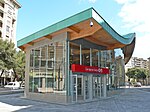University of Zaragoza
1542 establishments in SpainBuildings and structures in ZaragozaEducation in AragonEducational institutions established in the 1540sPublic universities ... and 2 more
Universities and colleges in SpainUniversity of Zaragoza

The University of Zaragoza, sometimes referred to as Saragossa University (Spanish: Universidad de Zaragoza) is a public university with teaching campuses and research centres spread over the three provinces of Aragon, Spain. Founded in 1542, it is one of the oldest universities in Spain, with a history dating back to the Roman period. Prime Ministers Pascual Madoz, Manuel Azaña, Salustiano de Olózaga and Eusebio Bardají, the Nobel Prize laureate and father of modern neuroscience Santiago Ramón y Cajal, the catholic saint Josemaría Escrivá and the Cuban national hero Jose Marti studied at this University.
Excerpt from the Wikipedia article University of Zaragoza (License: CC BY-SA 3.0, Authors, Images).University of Zaragoza
Calle Violante de Hungría, Zaragoza Romareda (Universidad)
Geographical coordinates (GPS) Address Nearby Places Show on map
Geographical coordinates (GPS)
| Latitude | Longitude |
|---|---|
| N 41.6420639 ° | E -0.9015065 ° |
Address
Campus San Francisco - Universidad de Zaragoza
Calle Violante de Hungría
50009 Zaragoza, Romareda (Universidad)
Aragon, Spain
Open on Google Maps









